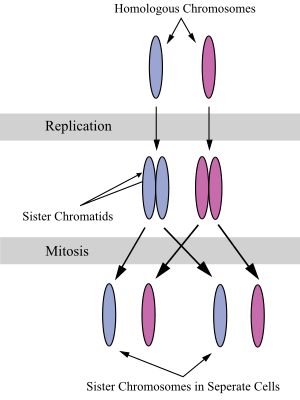

A sister chromatid refers to the identical copies (chromatids) formed by the DNA replication of a chromosome, with both copies joined together by a common centromere. In other words, a sister chromatid may also be said to be 'one-half' of the duplicated chromosome. A pair of sister chromatids is called a dyad. A full set of sister chromatids is created during the synthesis (S) phase of interphase, when all the chromosomes in a cell are replicated. The two sister chromatids are separated from each other into two different cells during mitosis or during the second division of meiosis.
Compare sister chromatids to homologous chromosomes, which are the two different copies of a chromosome that diploid organisms (like humans) inherit, one from each parent. Sister chromatids are by and large identical (since they carry the same alleles, also called variants or versions, of genes) because they derive from one original chromosome. An exception is towards the end of meiosis, after crossing over has occurred, because sections of each sister chromatid may have been exchanged with corresponding sections of the homologous chromatids with which they are paired during meiosis. Homologous chromosomes might or might not be the same as each other because they derive from different parents.
Existe evidencia de que, en algunas especies, las cromátidas hermanas son la plantilla preferida para la reparación del ADN. [1] La cohesión de las cromátidas hermanas es esencial para la correcta distribución de la información genética entre las células hijas y la reparación de los cromosomas dañados. Los defectos en este proceso pueden provocar aneuploidía y cáncer, especialmente cuando los puntos de control no detectan daños en el ADN o cuando los husos mitóticos conectados incorrectamente no funcionan correctamente.

La recombinación mitótica es principalmente el resultado de procesos de reparación del ADN que responden a daños espontáneos o inducidos. [2] [3] [4] La reparación recombinante homóloga durante la mitosis se limita en gran medida a la interacción entre cromátidas hermanas cercanas que están presentes en una célula después de la replicación del ADN pero antes de la división celular. Debido a la relación especial cercana que comparten, las cromátidas hermanas no solo se prefieren a las cromátidas homólogas distantes como sustratos para la reparación recominacional, sino que también tienen la capacidad de reparar más daños en el ADN que los homólogos. [1]
Los estudios con la levadura en ciernes Saccharomyces cerevisiae [5] indican que la recombinación entre hermanas ocurre frecuentemente durante la meiosis, y hasta un tercio de todos los eventos de recombinación ocurren entre cromátidas hermanas. [ cita necesaria ]